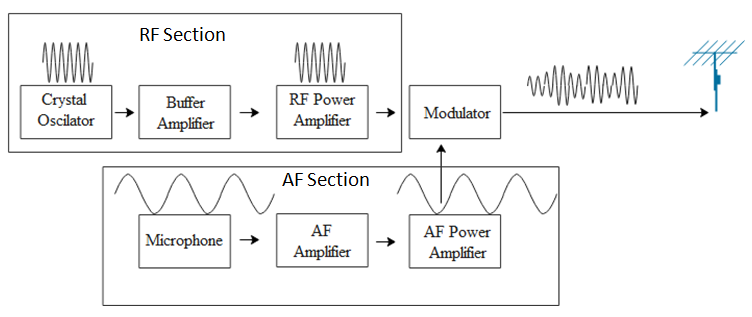
Draw the block diagram of Amplitude Modulated (AM)radio transmitter.
Answer
582.6k+ views
Hint: The AM radio transmitter consists of two sections. The audio frequency (AF)section and the radio frequency section. The signal basically gets generated in the AF section and modulated in the RF section. From this information we will draw the block diagram of the Amplitude Modulated (AM)radio transmitter.
Formula used:
$U=-\dfrac{GMm}{r}$
$K=\dfrac{1}{2}m{{v}_{0}}^{2}$
Complete step by step answer:
To begin with let us first understand what do we mean by modulation.
It is found that the height of the receiver antenna has to be at least one fourth of the wavelength of the signal. Hence we cannot use the audio signal directly as they have very large wavelengths and for that purpose we would require a huge antenna. Hence, this signal is superposed with a signal of high frequency such that the amplitude of the signals remains the same but wavelength of the signal is reduced. This process is called amplitude modulation. Given below is a block diagram for Amplitude Modulated (AM)radio transmitter.

Note:
In the above block diagram we can see that the signal is generated through the microphone. The magnitude of energy of the signal is very poor and hence, it is fed to the AF amplifier. This signal is further powered up by the AF power amplifier and sent to the modulator. The modulator is the place where the superposition of the carrier wave and the signal generated takes place. The crystal oscillator generates the high frequency carrier wave which is sent to the buffer which isolates the RF power amplifier keeping the frequency of the crystal controlled oscillator constant. Further the modulator mixes the carrier wave and the AF signal, which is fed to the antenna for transmission.
Formula used:
$U=-\dfrac{GMm}{r}$
$K=\dfrac{1}{2}m{{v}_{0}}^{2}$
Complete step by step answer:
To begin with let us first understand what do we mean by modulation.
It is found that the height of the receiver antenna has to be at least one fourth of the wavelength of the signal. Hence we cannot use the audio signal directly as they have very large wavelengths and for that purpose we would require a huge antenna. Hence, this signal is superposed with a signal of high frequency such that the amplitude of the signals remains the same but wavelength of the signal is reduced. This process is called amplitude modulation. Given below is a block diagram for Amplitude Modulated (AM)radio transmitter.

Note:
In the above block diagram we can see that the signal is generated through the microphone. The magnitude of energy of the signal is very poor and hence, it is fed to the AF amplifier. This signal is further powered up by the AF power amplifier and sent to the modulator. The modulator is the place where the superposition of the carrier wave and the signal generated takes place. The crystal oscillator generates the high frequency carrier wave which is sent to the buffer which isolates the RF power amplifier keeping the frequency of the crystal controlled oscillator constant. Further the modulator mixes the carrier wave and the AF signal, which is fed to the antenna for transmission.
Recently Updated Pages
The number of solutions in x in 02pi for which sqrt class 12 maths CBSE

Write any two methods of preparation of phenol Give class 12 chemistry CBSE

Differentiate between action potential and resting class 12 biology CBSE

Two plane mirrors arranged at right angles to each class 12 physics CBSE

Which of the following molecules is are chiral A I class 12 chemistry CBSE

Name different types of neurons and give one function class 12 biology CBSE

Trending doubts
Which are the Top 10 Largest Countries of the World?

What are the major means of transport Explain each class 12 social science CBSE

Draw a labelled sketch of the human eye class 12 physics CBSE

Differentiate between insitu conservation and exsitu class 12 biology CBSE

State the principle of an ac generator and explain class 12 physics CBSE

Differentiate between homogeneous and heterogeneous class 12 chemistry CBSE




